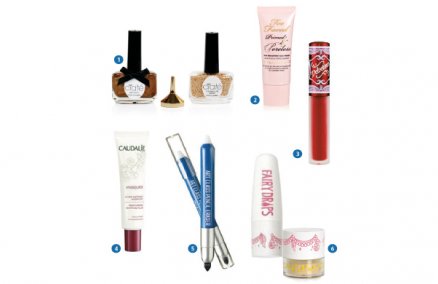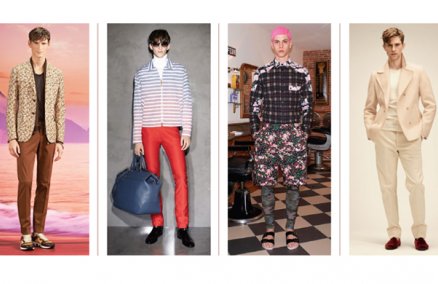Diane von Furstenberg
When a dress that is poured over the female form to bring out her best assets is discovered, history is made. And that is exactly what Belgian fashion designer Diane von Furstenberg (DVF) did in 1972. Celebrating the contours of the woman’s body, the wrap dress became synonymous with women’s liberation, and who better to represent the movement than von Furstenberg herself?
“My role as a fashion designer is to give women clothes that will enhance their personalities,” she says. “The wrap dress is timeless and classic … it is worn the same way it was worn in the ’70s … and it is effortless.”
Von Furstenberg has, since then, kept that as an underlying inspiration for all her collections. The stunning showcase of her autumm/winter collection at the recent Singapore Fashion Festival exuded her signature style of subtle sexiness, coupled with functional femininity. Weightless satin and silk chiffons fluttered gracefully on dresses suited for glamorous evenings, while classic bold prints on snug silhouette pieces fluently hugging the female form spelt practical day wear.
Without formal education or training in fashion, von Furstenberg was dabbling with jerseys when the light bulb to the legendary wrap dress flashed. Daughter of an Auschwitz survivor, ex-wife to an Austrian Prince and former cover girl of Newsweek, the designer is an amalgamation of beauty and strength. It is this epitome of independence and glamor that has been incorporated into the way she fashions her clothes.
Women are, and always have been, powerful engines in society, and von Furstenberg created for them an avenue to feel confident and commanding without having to compromise their femininity—seen especially in her recent show here that featured many colorful and fun gowns, skirts, blouses and jackets that went beyond her signature warp dresses. “The Diane von Furstenberg woman is an independent woman who lives life to the fullest and is always on-the-go, so it is important to design clothes that allow her to go from the office to after-hours by simply changing her shoes.”
Today, the owner of chic boutiques in New York, Miami, London, Paris, Los Angeles and Hong Kong, has expanded her expertise to include cosmetics, swimwear and maternity pieces, to name just a few. And with the recent availability of her collection in Takashimaya, those who have always gone gaga over her pieces—which have graced the bodies of many international celebrities such as Madonna, Ashley Judd and Paris Hilton—can now bask in their very own.
Glamorously modeled after a glittering jewel box, her boutique is chic and posh. Always keeping elegance and comfort composite, she promises to keep “dresses and separates in lighter fabrics, like silk chiffon or charmeuse, that are breathable, fluid and appropriate for the weather in Singapore.” From the latest runway designs to easy wear dresses, feel and look like royalty without even trying. Live it up DVF style, day and night.
Available from Diane von Furstenberg, 2/F, Takashimaya, 391 Orchard Rd., 6732-6626.
alldressedup
When recently cat-walked at the Singapore Fashion Festival, insiders lauded alldressedup as one of the most accessible and striking Singaporean collections to ever show at the four-year-old event.
alldressedup, the homegrown fashion label from Sven Tan, available exclusively from The Link at Mandarin Gallery, has moved on from its “Out of Africa”-themed collection last year—which featured mostly dresses and accessories adorned with braids, leather cords and trims—to something sexier and more modern.
Drawing influences from Japan and Morocco, alldressedup’s autumn/winter pieces are made with both working and party girls in mind. The lines are clean and the materials, infused with delicate origami details and Islamic jacquard title prints, are subtle and gorgeous all at the same time.
But what stands out most from the collection, especially its gowns and dresses, is that they are not as elaborate and haute couture-based as Tan’s previous series, and they are more accessible and effortless in their execution. “In the spirit of modernity, this collection is tailored for every modern woman who truly appreciates the allure of effortless grace and uncontrived sensuality,” Tan says of his new direction. “The concept evolves around the idea of contrasts and oppositions: A bit feminine, a bit boyish, a bit sporty and a bit sophisticated. But the main objective is always to create a versatile collection that is absolutely desirable.”
Indeed, alldressedup’s latest series is just that, desirable. From the plain white dress which comes replete with detailed and gorgeous origami prints and illustrations that won’t look out of place in any art gallery; to the bold, chunky, yet inherently feminine accessories; to some highly wearable and comfortable dresses featuring see-through linen jersey; to funkier jackets and blouses made out of Swiss cotton embroidery anglaise and silk micro taffeta, it is a uniformly eclectic, stylish and highly coveted collection.
“The pieces are designed for the bohemian-spirited traveler in every woman who owns her style,” says Tan. “This season, the collection may have traveled to a new destination, but the spirit of alldressedup remains unchanged. It is not an evolution of design but always a modern interpretation of a multi-faceted woman. Depending on the styling, this collection can be styled for most occasions.”
Certainly, the dresses from alldressedup are some of the most inspired we’ve seen from a Singaporean designer, and depending on how one mixes and matches them with various accessories, bags and shoes, these ready-to-wear pieces are good to go for any social meeting, or for a wild night out in the clubs.
Available from The Link, 1/F, Mandarin Gallery, 333 Orchard Rd., 6836-3238.
Ashley Isham
Our homegrown London-based fashion designer Ashley Isham brought luster and magic into the Singapore fashion industry recently. His awe-inspiring collection, lauded for its energy, fluidity and movement, was one of the star attractions at last month’s Singapore Fashion Festival.
Touted as one of London’s most sought- after fashion talents, with an unprecedented rise through the rungs of the global fashion capital within just five years and a flagship boutique called Ashley’s off Bond Street, Ashley was one of the prestigious judges at the recent Mercedes-Benz Asia Fashion Award Regional Finals 2006.
Make no mistake: This highly acclaimed fashion designer’s interest in fashion did not spark off from any whimsical or fairytale-like milestone event in his life, but rather from his simple, down-to-earth mother who worked as a seamstress when he was a child.
Design-wise, Ashley derives inspiration for his clothes, from anything and anywhere—from photographs to art pieces that he sees at galleries and museums. “From my college days at St. Martin’s in London, I have learnt how to put a proper collection together,” he explains. “After getting ideas from various sources, I develop a mood board … that’s the beginning of a collection. I believe that you can find inspiration anywhere if only you are willing to absorb.”
Having a critical eye for both East and West elements, Isham is able to fuse Asian glittery motifs like prints, beading and exquisite threadwork into well-draped fabrics. His eclectic collections range from simple but elegant summer dresses, to dramatic, floor sweeping evening gowns. With a finesse for differing cuts and styles, he incorporates a matchless glamor and sophisticated touch to each of his feminine designs.
Isham, however maintains that draping remains his signature style, and discovering silhouette is his forte. His favorite all-time piece is his spring/summer red halter neck dress.
Despite the groundbreaking success of Ashley’s boutique in London, and being made the official womenswear stylist during the 2004 British Academy of Film and Television Arts for actresses such Angelina Jolie and Catherine Zeta-Jones, Isham is not resting on his laurels. He is launching a new Ashley Isham Demi Couture line, which is an even more glamorous collection than his main one. “I have noticed that women are now more discerning and more glamorously dressed,” he states, when asked about how his entrance into the fashion business has affected the industry.
Indeed, though Ashley Isham’s clothes collection since inception seems to be accessible to the rich and glamorous of London and Hollywood, it is still well within reach of Singapore women, here and now.
Available from Pois, #02-47/48 Paragon, 290 Orchard Rd., 6238-0151.
Advertisement


















